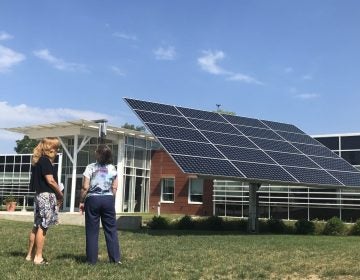Cutting carbon pollution quickly would save millions of lives, study finds

A wind farm in Wyoming generates electricity for a region that used to be more dependent on coal-fired power plants. A new study finds that millions of lives could be saved this century by rapidly reducing greenhouse gas emissions. (Matt Young/AP)
Cutting greenhouse gas emissions quickly would save tens of millions of lives worldwide, a new study finds. It’s the latest indication that climate change is deadly to humans, and that the benefits of transitioning to a cleaner economy could be profound.
In recent years, the connection between a hotter planet and human death and disease has become clearer, thanks to a series of research papers. A study published in 2021 found that about a third of heat-related deaths worldwide can be directly attributed to human-caused climate change. A 2020 Lancet report warned that climate change is the biggest global public health threat of the century.
But those findings have not been factored into one of the three major computer models that scientists, economists and the federal government use to calculate the societal costs of carbon emissions. That means economists and policymakers may be underestimating the cost of climate change to human life.
“One key takeaway is that there are a significant number of lives that can be saved by reducing emissions,” says R. Daniel Bressler, a Ph.D. candidate at Columbia University who is the author of the new study, published Thursday in the journal Nature Communications.
When he factored in the latest mortality research, Bressler found that about 74 million lives could be saved this century if humans cut greenhouse gas emissions to zero by 2050, compared with a scenario in which the Earth experiences a catastrophic 4 degrees Celsius (about 7 degrees Fahrenheit) of warming by the end of the century.
He hopes the findings will be helpful to a federal working group currently reassessing how the government calculates the costs and benefits of climate policies. Since 2010, the federal government has calculated the “social cost of carbon” — a dollar amount that represents the cost associated with emitting 1 metric ton of carbon dioxide into the atmosphere. Those costs include changes to agricultural productivity, energy use, species extinction, sea level rise and human health.
The social cost of carbon informs trillions of dollars of federal policy, including regulations about vehicle tailpipe emissions, power plants and appliance efficiency standards.
“There have been over 100 U.S. government regulations where the social cost of carbon was used,” says Maureen Cropper, a climate economist at the University of Maryland, who co-chaired a 2017 National Academies of Sciences committee on the social cost of carbon.
At least 11 states also use the social cost of carbon to inform decisions about their power grids, efficiency regulations and other climate policies, Cropper says, and Canada based its own cost number on the original U.S. calculations.
Having an accurate cost number is especially important at a time when Congress and state governments are considering major infrastructure investments, Bressler says.
“Imagine you’re looking at the cost-benefit analysis of building a new power plant,” Bressler says. “You’re trying to compare a coal plant to a wind farm. And that coal-fired power plant is producing a lot more carbon dioxide emissions. How do we think about the costs associated with that?”
It depends on whom you ask. Under the Obama administration, the cost associated with emitting carbon was calculated to be at least seven times higher than under the Trump administration, mostly because the latter purposely ignored the effects of U.S. emissions on the rest of the world.
President Biden reinstated the Obama-era cost number and directed a federal working group to reexamine the calculation to make sure it includes the most up-to-date research about the costs of climate change. A new cost number is expected in early 2022.
9(MDAzMzI1ODY3MDEyMzkzOTE3NjIxNDg3MQ001))




